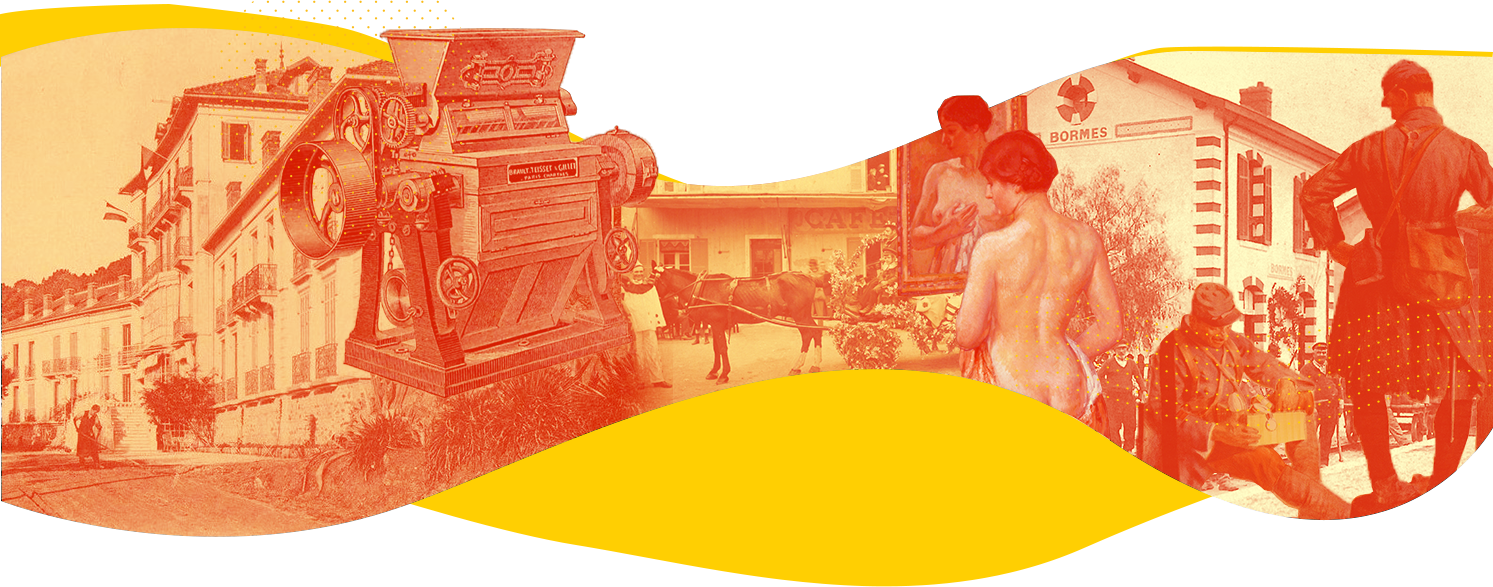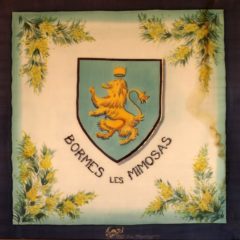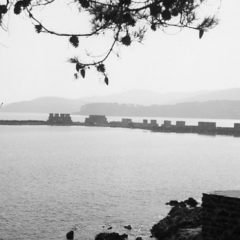


Contemporary period
From 1789 to our days
1830
Industrial Revolution
The industrial revolution, which arrived around 1830, profoundly transformed the local activity. The water or wind mills were abandoned because their use was often disrupted by the lack of water in the streams or by wind surges. In the big cities, the recent steam mills can run day and night, as long as they are regularly fed. They are more efficient and contribute to the disappearance of traditional mills.
1884
The installation of the coastal railroad
The year of the decision to build the Chemin de Fer du Littoral was the year of the decision to build the Chemin de Fer du Littoral. The concession agreement was signed by the Prefect of the Var on September 19 of that year.
After Pharaonic works, disrupted by countless land acquisitions, expropriations and various difficulties encountered on the ground, the Hyères la Foux section, including the Bormes station passage, was opened to the public on August 4, 1890.
The newly created CP railway company was of great service to the development of the town of Bormes. The road network was limited and often in poor condition, making travel hazardous. Visitors from all over the world and local products could now travel more easily and participate in the development of the town.
1903-1906
Construction of the grand hotel
In the same period as the Industrial Revolution, the Mediterranean shores saw the arrival of a new population that came to take advantage of the therapeutic benefits that the region’s climate could offer. The first tourists came to take advantage of the fresh air, the winter sun and the presence of nature everywhere.
After Queen Victoria’s visit to Hyères in April 1892, the region turned to high-end tourism, attracting wealthy families from around the world. Hotels of great standing and luxury villas were built. As early as 1889, railroads were built around Marseille, all along the coast. The installation opened up hamlets and villages, until then isolated from the big cities. The local production of cork, cut flowers or even fishing products took the train to the big cities.
In Bormes, the Grand Hotel was built at the top of the village, dominating the plain. Its construction took place between 1903 and 1906. The hotel was a great success from the moment it opened.
1913
Bormes becomes a climatic resort
The year 1913 represents a major step for the village of Bormes. As a result of the community’s work and determination, the village became a “climatic resort”: it positioned itself at a high level of service quality. In order to comply with the new classification, major sanitation and drinking water access works have been undertaken. Le lavandou, the fishermen’s district of the commune, asks to become a commune in its own right, separated from Bormes. With this separation, the commune of Bormes is cut off from a large part of its surface area and half of its population.
1914-1918
World War I
1st world war. Even if the war of trenches takes place far from our region, the young population and in age to make turn the economy of the commune, must now join the front. Not all of them will come back, the nation’s living forces, which had survived the Great War, are under the influence of a deadly Spanish flu epidemic as early as 1919. For Bormes, the “lack of manpower” will be so important that the activities, notably those of olive oil production, will be disrupted, sometimes leading to the definitive closure of production sites.
1920
First official parade of Bormes les Mimosas
Between the two world wars, the region tries to regain an acceptable level of activity.
A traditional festival, dating back to the 17th century, the “carreto ramado” (the flowered cart) is brought back to life in a post-war France. The 1st official flower parade of the village was officially born at the beginning of 1920. It is a small parade of carts decorated with seasonal flowers and branches. It was a celebration of the arrival of good weather and the hope of better days with abundant harvests.
1926
Foundation of the municipal museum
The Museum of the village of Bormes les Mimosas was created by the painter Emmanuel-Charles Benezit, in 1926. The collection made available to the painter is rich in several works, including 8 drawings and studies of the painter and engraver Jean Charles Cazin.
As soon as the Bormes Museum was created, Benezit ensured its conservation, completing the collection with several works donated by artists,
The municipal museum of Bormes was set up in the large room on the first floor of the town hall and the works were exhibited in the council room.
The first exhibition of works of art under the banner of the newly created museum is organized by the artistic home “Lou Calen” from March 28 to April 11, 1919. from March 28 to April 11, 1926.
34 artists participated, among them Lucien Pissarro, Theo Van Rysselberghe, Edmond Cross and Alfred Courmes.
1939-1945
World War II
Until 1942, the commune was in the free zone. In response to the landing of the Allies in North Africa on November 8, 1942, Italian troops came to occupy the southern region, Corsica, the Dauphiné and part of Savoy. They remained in the area until September 8, 1943, the date of the Cassibile Armistice. The Italians were replaced by German troops until the Provence Landing on August 15, 1944.
After the war, the village resumed its tourist activities. Tourism became more democratic, and the coastal towns had to equip themselves with modern infrastructures, roads, hotels and individual houses.
1948
Closure of the railroad line
After the Second World War, the region was struggling to recover from several years of occupation, which caused significant damage to the local economy. The railroad suffered a lot of damage following the landing in Provence on August 15, 1944, and the question arose as to whether to raise the necessary capital to rebuild the line or to develop the transport of passengers and goods by road. Faced with the urgency of the decision to be taken, the use of road transport was implemented, sounding the death knell of the Toulon – Saint Raphael line.
The Cp railway company ran its last train in October 1948, and the network was definitively abandoned.
1968
Bormes becomes Bormes les mimosas
The year 1968 is important in two ways. The village, always simply called Bormes, with its variations over the centuries, became Bormes les Mimosas. The name of the village was joined to that of a tree emblematic of the region. The mimosa is a species that appeared around 1830, in the gardens of wealthy owners who came to acclimatize a species brought from Australia.
That same year, the Fort de Brégançon, a former military place decommissioned in 1919, rented to private owners, then transformed into a holiday residence for the Presidents of the French Republic, was classified as a historical monument.
1969-71
Construction of the port of Bormes
Tourism on the Côte d’Azur has taken on an international dimension. The 70’s were also the years of the nautical industry. Wooden boats, heavy and expensive to maintain, were no longer manufactured, but new materials were preferred, such as fiberglass and resin for boat hulls. It is a material allowing industrial construction in series.
Boating was becoming more democratic, and the need for space in the port was sorely felt. The old ports were enlarged, and new projects were started. It is in this constructive euphoria that the Port of Bormes was born, between 1969 and 1971.
1985
Installation of the museum on Carnot Street. Opening to the public
Since 1934, the Metzger and then Taieb families had owned the building on Carnot Street and had given a new lease of life and allure to the old house, which was threatening to fall into ruin.
In 1977, the Taieb family decided to put the family house up for sale, and the municipality became the purchaser and finalized its intentions by signing a deed of sale on September 22, 1978.
The municipality has the ambitious project to install in the future, the collections of works and to organize exhibitions and events of the cultural life of the village.
Once the rehabilitation work was completed, the Museum of Arts and History of Bormes les Mimosas was inaugurated on July 8, 1985 and opened to the public, meeting with immediate success.

